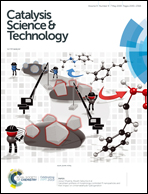Comprehensive study of the promotional mechanism of F on Ce–Mo/TiO2 catalysts for wide temperature NH3-SCR performance: the activation of surface ![[triple bond, length as m-dash]](https://www.rsc.org/images/entities/char_e002.gif) Ti–F bonds†
Ti–F bonds†
Abstract
CeTiOx, CeFTiOx, CeMoTiOx and CeFMoTiOx catalysts were prepared by solvothermal synthesis, and the effect of element doping on the structures, chemical properties and SCR reactivity of the catalysts has been investigated by experimental analysis and density functional theory (DFT) calculations. The selective catalytic reduction (SCR) performance, operation window, H2O/SO2 durability and airspeed resistance of the CeFMoTiOx catalyst were notably improved or optimized via the simultaneous introduction of fluorine and molybdenum. The CeFMoTiOx catalyst presented satisfactory SCR performance by employing the advantages of inorganic element F and transition metal element Mo, which could increase the trapping sites and oxygen vacancies and enhance the synergistic interaction among metal oxide particles. Moreover, it was verified that Oα was generated except for the transformation between Ce4+ and Ce3+, and released from F− species instead of O2− into the lattice of TiO2 during the resistance SO2 test at 300 °C, which was favorable for the SCR reaction. Significantly, the internal electron transfer function between metal oxides and oxygen vacancies, as well as the activation of surface ![[triple bond, length as m-dash]](https://www.rsc.org/images/entities/char_e002.gif) Ti–F bonds played important roles in the process of SCR operation.
Ti–F bonds played important roles in the process of SCR operation.
![Graphical abstract: Comprehensive study of the promotional mechanism of F on Ce–Mo/TiO2 catalysts for wide temperature NH3-SCR performance: the activation of surface [[triple bond, length as m-dash]] Ti–F bonds](/en/Image/Get?imageInfo.ImageType=GA&imageInfo.ImageIdentifier.ManuscriptID=C9CY00256A&imageInfo.ImageIdentifier.Year=2019)


 Please wait while we load your content...
Please wait while we load your content...
![[triple bond, length as m-dash]](https://www.rsc.org/images/entities/h2_char_e002.gif) Ti–F bonds
Ti–F bonds